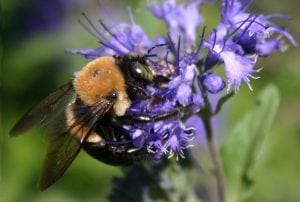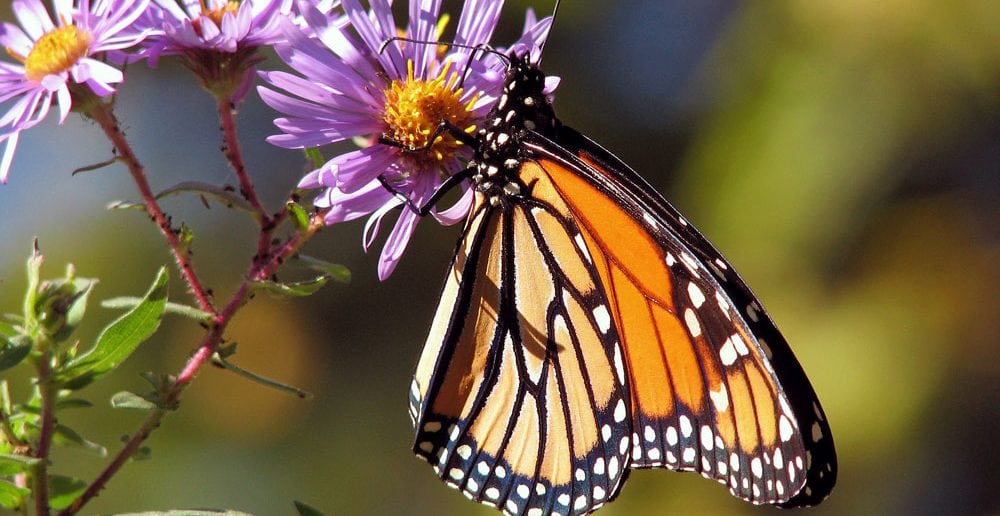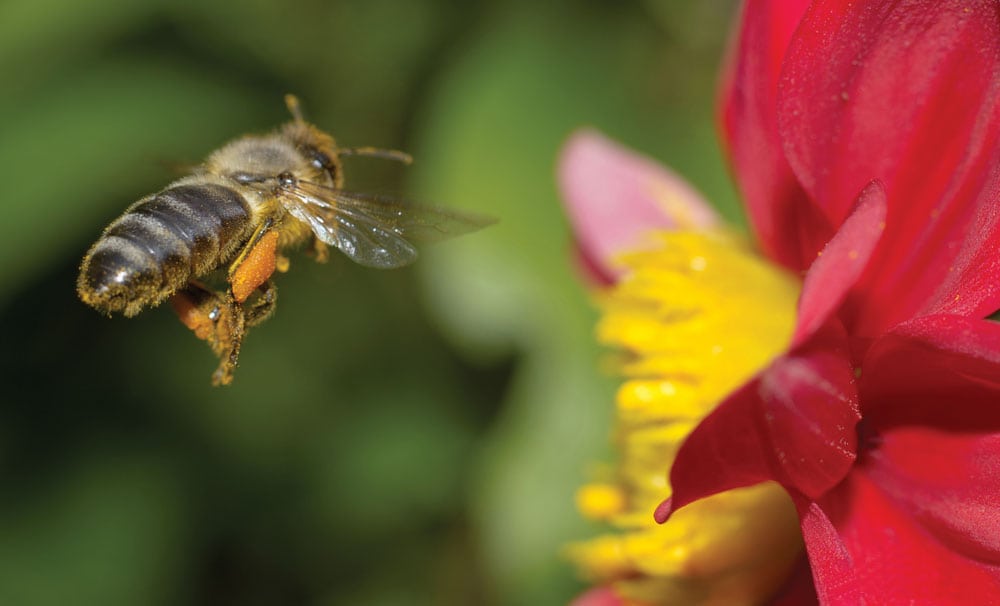If not for bees and other pollinators, the world would starve.
Those buzzing honeybees and bumblebees, colorful butterflies and quick-darting hummingbirds have a huge job to perform: pollinating plants that grow into the fruits and vegetables we eat and the blossoms we enjoy.
But to get a bountiful crop to harvest, gardeners need to feed the pollinators.

Dolores Savignano, climate change coordinator with the U.S. Fish and Wildlife Service Division of Fisheries and Habitat Conservation, encourages people to make their landscapes pollinator- friendly.
“Plant native plants, and provide nesting sites,” she said. “Native pollinators are adapted and attracted to native plants. Even though humans may sometimes find the cultivated varieties of natives more attractive in your landscape, they may not have all the traits of their native relatives.”
Many hybrid plants or hybrid varieties of natives have been developed with their appearance in mind but little consideration for the plant’s ability to produce nectar, pollen or fragrance. This is especially true of blooms that have been bred to have double flowers such as new colors of coneflowers and some daisies.
“Pollinators play a crucial role in the health of the ecology and even more so in our food sources,” said Savignano. “More than 75 percent of all crops require natural pollination.”
Honeybees enable the production of at least 90 commercially grown crops in North America, according to a White House fact sheet. Globally, 87 of the leading 115 food crops are dependent on animal pollinators, the fact sheet notes.
It says pollinators contribute more than $24 billion to the U.S. economy, with honeybees responsible for more than $15 billion of that through their vital role in keeping fruits, nuts and vegetables in our diets. Native wild pollinators such as bumblebees and alfalfa leafcutter bees account for the balance.
Created for a purpose
In the great scheme of pollination, bees do the heavy lifting — not only to ensure continued food production but to ensure reproduction of plants, shrubs and trees. Their pollination creates seeds so plants can reproduce.
“Bees are the real workhorses in the world of pollination,” said Gail Langellotto-Rhodaback, Oregon State University associate professor in urban and community horticulture and statewide master gardener program coordinator. “Butterflies are beautiful, but they’re not nearly as efficient as bees.
“The face of our food system would change markedly if it weren’t for bees. It would be impossible for humans to replicate natural pollination because of tiny flowers and plant parts.”
With hairy bodies and pocket-like structures on their back legs to transport pollen back to the hive, bees are created to be pollinators. Bee larvae feed on pollen, so they are conditioned to seek it as adults.
For bees, it is a matter of their survival. Pollination is part of nature’s balance in the environment.
Creating bee-friendly places around your landscape can help. Bees that nest above ground or on the surface can quickly convert a clump of grass, a pile of sticks and twigs or a cavity in an old tree trunk into an ideal home.
Some bees prefer underground nests. They typically take over an unused rodent hole or tunnels from other insects.
“Without thinking about it, many of us limit the places that underground pollinators can nest when we try to regrow grass or vegetation in a bare spot in our yards,” said Savignano. “Bees will naturally look for sandy, loamy, bare soil to make their nests, or they may seek out soft wood or the base of a clump of grass. They also prefer pithy stems of perennials or old vegetable plants, so delay your garden cleanup over the winter to provide other options.”

Incidental pollinators
Butterflies, hummingbirds, moths, flower flies, beetles and wasps pollinate with varying degrees of efficiency. Unlike bees, their success is almost by accident.
“They’re called incidental pollinators because in their flitting from flower to flower, butterflies and hummers harvest life-giving nectar for themselves,” Savignano said.
As they dine on sweet nectar, pollen may dust their wings or feathers and is transferred to other flowers and plants upon which they light. The rapid beating of their wings also aids in pollination.
Some butterflies are indigenous by region. Others such as the monarch, known for its annual migration from the United States and Canada to warmer climates each winter, are commuters.
In October, monarchs head to southern California and a group of specific mountaintops in central Mexico to hibernate until mid-March. After mating at the end of the winter, they return north in search of Monarch-friendly plants such as milkweed, Joe Pye weed and other native wildflowers, where they lay their eggs.
When the eggs hatch, the larvae feed on these plants and grow into colorful caterpillars with black, white and yellow stripes.
They shed their skin five times before undergoing metamorphosis to form the chrysalis that hangs from a plant stem or twig. After about 10 days, the pupa — the skin of the chrysalis — opens and a fully grown butterfly appears.
“Monarchs are by far the most wide-ranging butterflies,” said Langellotto- Rhodaback. “They are somewhat at risk because of the loss of the habitat they require.”
For monarchs in their caterpillar stage, green leaves and tender stems are the best food source. As they morph into butterflies, their diet changes: Instead of chewing leaves, they seek out nectar and juice from certain fruits.
You can put out bits of oranges, overripe bananas or other fruits for butterflies to provide additional nutrients to complement their diet.
Help expand the food source for hummingbirds by hanging a feeder filled with four parts water to one part table sugar. There is no need to add red food coloring. Hummingbirds can find the feeder as long as there is something red on it.
Because hummingbirds are territorial, put up several feeders around your yard. Clean them regularly.
Catering to pollinators
A national movement to increase habitat for pollinators has created a plethora of information about what attracts pollinators, how to create habitats and even how to become certified as a pollinator habitat.
The U.S. Department of Agriculture/ Forest Service offers these tips:
- Consider plants with a range of bloom seasons from spring through fall. Include both daytime and night-blooming species.
- Pollinators more easily find plants in clumps rather than single plants. This also makes your garden more attractive and easier to maintain.
- Choose native varieties of plants rather than their “prettier” hybridized relatives. Mix in annuals, perennials, flowering shrubs and trees.
- Check with your area’s Extension office or a Master Gardener for a list of the best natives to plant to attract your region’s pollinators. Some may be considered weeds in your area.
- Provide a water source for pollinators. You can put a bird bath directly on the ground or install a drip irrigation line. Add a bit of salt or wood ashes to the damp area. Do not remove dead trees or branches. They may become attractive nesting options for bees.
- Avoid the use of pesticides. If you must use them, read the label for the least-toxic to wildlife. Spray at night when bees are not active.
- Learn more about pollinators by reading guidebooks about bees, butterflies and hummingbirds. Numerous organizations provide resources and hold events that raise awareness about the importance of pollinators.
The North American Pollinator Protection Campaign, www.pollinator.org, spearheads National Pollinator Week each June. In 2016, organizations across 42 states, Puerto Rico and Canada created more than 170 events to draw attention to the importance of pollinators.
The Jimmy Carter Presidential Center in Atlanta hosted a discovery day that featured the Rosalynn Carter Butterfly trail and exhibits by several dozen bee, butterfly and pollinator groups. The Yoga Butterfly Festival in Weston, Florida, included native plant giveaways and interactive activities for children and adults. In Portland, Oregon, the campaign featured a pollinator safari.
Mother Nature has created an intricate system to take care of all creatures big and small, but sometimes she could use a little help.
“Bees and other pollinators have small brains, so they can only search for one or two things at a time,” said Langellotto- Rhodaback. “Anything we can do to attract them to our yards and gardens for pollination will encourage even more pollination.”



